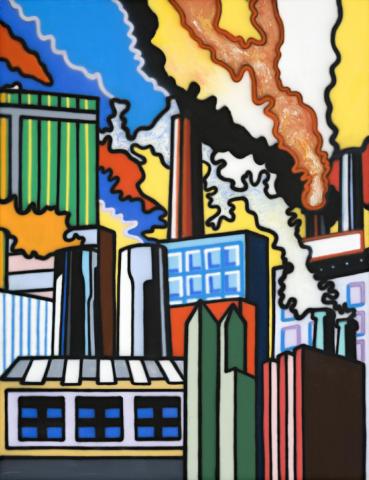SHADOW FACTORIES, 1989
HOWARD ARKLEY
synthetic polymer paint on canvas
175.5 x 134.5 cm
signed, dated and inscribed verso: Howard ARKLEY / Shadow Factories / 1989 ... / Howard Arkley
Private collection, Melbourne
Private collection, Melbourne
Mossgreen, Melbourne, 16 November 2010, lot 8
Private collection, New South Wales
Shadow Factories, 1990, synthetic polymer paint on canvas, 166.0 x 240.0 cm, illus. in Crawford, A, and Edgar, R., Spray: The Work of Howard Arkley, Craftsman House, Sydney, 1995, pp. 94–95
This is, perhaps, Gotham as seen by Heath Ledger when he played The Joker. Not the morbid noir-ish dystopian city settling into its own 'ruin porn', but an environ pulsating with strange potentialities, where even plumes of smoke can take on the hue of Marge Simpson's coif.
Using motifs from Batman or The Simpsons is not a sacrilege when it comes to discussing Howard Arkley's dense and complex oeuvre. Like the Pop masters of the '60s and '70s, Arkley was fascinated by popular culture. His studio was a riot of magazines and advertising detritus, cut-up, scrawled upon, notated. The floor of his studio was the other extreme of his tightly rendered canvases, where structure, balance and surface were all important.
Amongst the strewn source materials one could spy his own polaroids of the belching factories of Richmond or newspaper articles discussing environmental disasters in Eastern Europe. But Arkley's Shadow Factories weren't comments on environmentalism and pollution per se. Like his suburban homes and soaring freeways they were marvels of structure and design and templates for a riot of colour. The sleek linear linework of the chimneys emboldened in green or red, the billowing clouds incandescent blues or sulfurous oranges.
As much as his polaroids and clippings, Arkley had been directly inspired by Peter Carey's 1987 short story Report on the Shadow Industry in which a town is subsumed by 'shadow factories' which spout 'beautifully coloured patterns' into the clouds. The townsfolk in Carey's story stand entranced, hypnotised by the smoke. Arkley's notion of industry is clearly more akin to Willie Wonka's Chocolate Factory than William Blake's Dark Satanic Mills.The artist was far from afraid of Shadow Factories inspiring debate about the environment. He relished such discussions but, as with the common clichés about suburbia, he refrained from taking a side, maintaining an ambivalence that was both frustrating and endearing. Similarly he could see the ironies inherent in the factory as subject. Firstly, the factory is usually the target for graffiti artists, the massive blank walls a perfect canvas for the spray can, a medium Arkley made his own in so many ways. Secondly, the factory, once deserted, almost inevitably becomes the locale for warrens of artists' studios. Far from producing cotton or cans, the factory-product becomes painting and sculpture. Inner-city factories eventually and inevitably become an outlet for dreams.
Arkley was a master of finding the magic in the mundane, of finding beauty in the everyday. He became an alchemist, turning the bland into gold, ingesting color into the suburban and the industrial alike. In 1989, when Shadow Factories was produced, Arkley was at the peak of his powers. Only ten years later would he be truly acknowledged by representing Australia at the Venice Biennale. Sadly that was also the year of his untimely death.
One can only hazard to guess what Arkley's factory is producing, but one may suspect that it is a dream factory- its produce is fantasia.
ASHLEY CRAWFORD
